
How to Diagnose Appendicitis?
The appendix is a small tube-like organ attached to your large intestine. It doesn’t perform any critical function but can get clogged or inflamed. Appendicitis is a serious condition that requires immediate treatment, preferably surgery. Appendicitis treatment in Navi Mumbai is for patients with severe abdominal pain in the lower abdomen. The condition can lead to a swollen appendix, which might eventually burst and become a life-threatening condition.
Causes and Symptoms of Appendicitis
Appendicitis occurs because of the bacterial overgrowth in the appendix. The bacteria from your large intestine can travel to the appendix, infect it, and clog the tube. Here are the symptoms of appendicitis:
- Abdominal pain around the belly button accompanied by nausea and vomiting
- Pain that’s persistent and keeps worsening
- Fever
- Bloated abdomen
- Frequent urination
- Diarrhea
If left untreated for a long time, your appendix can burst and the infection can spread throughout your body.
Diagnosing Appendicitis
The most common sign of appendicitis is pain in the abdomen, which shifts toward your appendix (lower part). Your healthcare provider will ask about your history of symptoms and run a few tests to diagnose appendicitis.
A) Physical Exam
Physical exam, i.e. putting pressure on the abdomen will worsen your pain. This happens because of the inflamed peritoneum. A digital rectal exam is another procedure that helps your doctor identify an inflamed appendix.
B) Imaging Tests
Imaging tests, like abdominal ultrasound and an X-ray, can help diagnose appendicitis easily. They will conduct further imaging tests, like a CT scan or an MRI, for a more accurate diagnosis. If the symptoms are confusing, imaging tests are used to identify the cause of pain.
C) Blood Tests
Blood tests help diagnose an infection in your body by checking the white blood cell count. The increased number of white blood cells indicates an active infection in your body.
In addition to these tests, the doctor will order a urinalysis to rule out the possibility of an infection of the bladder, urethra, and kidneys. These conditions can produce a similar range of symptoms. Likewise, the doctor will recommend a pregnancy test for women of their childbearing age.
Also Read: How to Reduce Appendix Pain?
Treatment of Appendicitis
The doctor for appendicitis surgery in Navi Mumbai will recommend an invasive surgical procedure to remove the inflamed appendix. That’s the only treatment for appendicitis. But before that, they will prescribe antibiotics to reduce infection. They will also conduct the above-listed imaging tests to evaluate the severity of the infection.
i) Medication
Appendicitis can be treated with antibiotics, but it’s unlikely that it will resolve with the medication alone. Your healthcare provider might recommend medication to treat the infection before they perform surgery. Note that appendicitis doesn’t resolve on its own. It will most likely return if the appendix is left intact and the pain and symptoms are resolved with medication.
ii) Surgery
Appendectomy is a surgical procedure used to remove the appendix either through an open surgery or a laparoscopic procedure. If you have had a laparoscopic procedure, you will recover faster and get discharged within a day or two.
Conclusion
In conclusion, it is critical to identify the signs of appendicitis and seek immediate medical assistance. To precisely diagnose the ailment, the diagnostic process includes physical examinations, imaging studies, and blood testing. Antibiotics can be helpful, but surgery is the best course of action; open or laparoscopic operations are two alternatives. Prompt intervention is essential to avoid complications, and following the prescribed treatment regimen guarantees a full recovery and return to health.

Can Hernia Be Treated Without Surgery?
A hernia is an unusual bulge caused by the organs that push through the weak muscle walls. The bulge is visible when you cough, sneeze, or put any kind of pressure on the affected area. Hernia can occur in the groin area, on your abdomen, and other parts of the body. They can be a birth defect or occur as you age. Hernias are also common in people who have undergone major surgery. Fortunately, hernia treatment in Navi Mumbai is available for those experiencing pain, discomfort, and other symptoms of hernia.
Non-Surgical Treatment Options
Unfortunately, the hernia will require surgery eventually. It doesn’t go away on its own. You can find temporary relief from certain medications, corsets that keep the bulge in place, and mild exercises, but these are only temporary solutions.
1) Medication:
Medication alone can’t help you get rid of a hernia, but it can relieve the symptoms and discomfort. For Hiatal hernia, you can take over-the-counter medication to relieve acid reflux and heartburn. Likewise, painkillers can help relieve pain.
2) Exercise:
If you practice high-intensity exercises or weightlifting, you might have to ask your healthcare provider if that’s safe. Any exercise that puts excess pressure on the bulge can make it worse. Talk to a hernia surgeon in Navi Mumbai and discuss the best exercises to prevent hernia from growing.
3) Dietary Changes:
Hiatal Hernias can cause GERD, heartburn, and many digestive issues. These are often triggered by certain foods that can cause your stomach acid to find its way to your throat. Take note of the foods that trigger these symptoms and focus on a healthy and balanced diet. Try to eat small and frequent meals.
4) Maintain a Healthy Weight:
Being overweight increases your risk of developing or worsening the existing hernia. It’s important to discuss your health goals with a healthcare provider and follow a weight-loss plan to shed those extra pounds.
Pros and Cons of Non-Surgical Treatments
As mentioned previously, hernia cannot be cured nor can it be reduced with manual treatments. You can take some steps to avoid the discomfort, pain, and other symptoms associated with the bulge, but you are eventually going to undergo surgery to have it fixed. The good news is a surgical procedure for hernia is minimally invasive and doesn’t take much time to heal.
You can also consider alternatives to open surgery, like robotic surgery or laparoscopic procedure. That said, not all types of hernias cause symptoms. There’s a chance the condition might go unnoticed and won’t require any repair either. It’s still best to consult your healthcare provider to ensure it won’t cause any complications. Let’s check out the pros and cons of non-surgical hernia treatments.
Advantages
- It can help reduce your hernia symptoms
- The non-invasive procedure doesn’t require any post-operative care
- You can carry out your routine activities
Disadvantages
- High risk of bowel obstruction
- Possibility of strangulation
- Hematoma
- Infections
See a healthcare specialist if you see the signs of hernia. Even if it’s causing any symptoms, it’s best to talk to a professional to rule out the possibility of any complications.

A Comprehensive Guide to Appendicitis: Symptoms, Causes, and Treatments
Introduction to Appendicitis
Appendicitis is a medical emergency when the appendix, a small, finger-like organ in the lower right side of the abdomen, becomes inflamed and infected. This condition can be extremely painful and, if left untreated, may lead to severe complications. This guide will explore the symptoms, causes, treatments, and prevention of appendicitis. If you’re in Navi Mumbai and require appendicitis treatment, it’s crucial to consult a skilled general surgeon in Navi Mumbai, such as those at Mangal Prabhu Hospital, who can provide timely and effective care.
Symptoms of Appendicitis
Recognizing the symptoms of appendicitis is essential for early diagnosis and prompt treatment. Common symptoms include:
i) Abdominal Pain
The most typical sign of appendicitis is a sharp pain that starts around the navel and gradually moves to the lower right abdomen. This pain often intensifies over time.
ii) Nausea and Vomiting
Many individuals with appendicitis experience nausea and may vomit due to the pain and discomfort.
iii) Loss of Appetite
A sudden loss of appetite is common when the appendix is inflamed.
iv) Fever
Appendicitis can lead to a low-grade fever, which may become more severe as the condition progresses.
v) Constipation or Diarrhea
Changes in bowel habits can occur, often with the patient experiencing either constipation or diarrhea.
vi) Abdominal Tenderness
The area around the appendix becomes tender and painful to the touch.
vii) Inability to Pass Gas
Some people with appendicitis find it difficult to pass gas.
Also Read: How To Reduce Appendix Pain?
Causes of Appendicitis
The exact cause of appendicitis is not always clear, but it is believed to result from one or more of the following factors:
a) Obstruction
Most cases of appendicitis are associated with a blockage in the appendix, often caused by stool, foreign objects, or an infection.
b) Infection
Infections within the digestive tract can lead to inflammation of the appendix.
c) Enlarged Lymphoid Follicles
Lymphoid tissue in the appendix can enlarge and lead to obstruction.
Treatments for Appendicitis
The standard treatment for appendicitis is surgical removal of the inflamed appendix, a procedure known as an appendectomy. This surgery can be performed using either traditional open or laparoscopic surgery, which is less invasive and typically results in a quicker recovery.
In some cases, if the appendix has formed an abscess (a pocket of infection), it may be drained before removing it surgically. It may involve a temporary drainage tube placement.
Prompt surgical intervention is crucial to prevent the appendix from rupturing, which can lead to severe complications, including peritonitis, a life-threatening infection of the abdominal lining.
Prevention of Appendicitis
- While appendicitis cannot always be prevented, some strategies may reduce the risk:
- Consuming a diet high in fiber may help prevent blockages in the appendix.
- Staying well-hydrated can help maintain healthy bowel function.
- Regular physical activity can promote overall digestive health.
- Practicing good hygiene, including regular handwashing, may reduce the risk of infection.
Conclusion
Appendicitis is a painful condition that requires prompt medical attention. You must consult a healthcare professional immediately if you experience symptoms like abdominal pain, nausea, vomiting, or fever. At Mangal Prabhu Hospital in Navi Mumbai, you can find experienced general surgeons who specialize in appendicitis treatment in Navi Mumbai. Early diagnosis and timely appendectomy are critical to a successful recovery and preventing complications. By understanding the symptoms, causes, and treatments of appendicitis, you can take the necessary steps to protect your health and well-being.

Is It Possible To Do Piles Treatment Without Surgery?
Piles can be a painful and uncomfortable condition affecting millions worldwide. Traditionally, surgical procedures have been the go-to option for treating piles. However, advancements in medical science have paved the way for non-surgical piles treatment options. Here, you will explore the possibilities of non-surgical treatment options. You’ll find this information valuable if you’re seeking Piles Treatment in Navi Mumbai.
What is Piles?
Piles, or hemorrhoids, are swollen blood vessels in the rectum or anus. They can be internal, occurring inside the rectum, or external, developing under the skin around the anus. Piles can be incredibly painful and lead to discomfort, bleeding, and itching. There are various causes behind the development of piles, making them a common health concern.
Causes and Symptoms of Piles
Several factors contribute to the development of piles, including chronic constipation, straining during bowel movements, pregnancy, obesity, and a sedentary lifestyle. Individuals with a family history of piles are also at an increased risk.
The symptoms of piles can vary from person to person, but common signs include:
- Rectal bleeding on toilet paper or in the toilet bowl after a bowel movement.
- Itching and irritation around the anus.
- Pain and discomfort during bowel movements.
- Swelling and lumps near the anus.
- Mucus discharge from the anus.
Non-Surgical Piles Treatment Options
Fortunately, surgery is not the only option for piles treatment. Non-surgical approaches have gained popularity due to their effectiveness and minimal invasiveness. Some of the non-surgical treatment options available include:
A) Medications
Over-the-counter creams and ointments can help relieve itching and pain associated with piles. A piles doctor in Navi Mumbai can prescribe prescription medication to reduce inflammation and discomfort.
B) Sclerotherapy
It involves injecting a chemical solution into the blood vessels around the piles, causing them to shrink and eventually disappear.
C) Rubber Band Ligation
In this procedure, a small rubber band is placed at the base of the pile, cutting off its blood supply. It causes the pile to shrink and fall off.
D) Infrared Coagulation (IRC)
IRC uses heat to shrink the blood vessels within the piles, reducing their size and relieving symptoms.
E) Laser Therapy
Laser treatment can precisely target and shrink piles, offering quick relief without surgery.
The Benefits of Non-Surgical Piles Treatment
Non-surgical piles treatment options offer several advantages over traditional surgical procedures:
- Minimal Pain
Non-surgical treatments are generally less painful, with shorter recovery times than surgery.
- Outpatient Procedures
Many non-surgical treatments can be performed on an outpatient basis, allowing patients to return home the same day.
- Lower Risk of Complications
Surgical procedures, such as infection and bleeding, carry certain risks. Non-surgical treatments have a lower risk of complications.
- Faster Recovery
Non-surgical treatments typically have quicker recovery times, allowing patients to resume their normal activities sooner.
Conclusion
Piles can be a source of immense discomfort, but it’s reassuring to know that surgery is not the only option for treatment. Non-surgical piles treatment options offer effective alternatives with fewer risks and a quicker recovery. If you’re in Navi Mumbai and seeking treatment for piles, consider consulting a piles doctor at Mangal Prabhu Hospital. At this hospital, you can explore various non-surgical options and find relief from this troublesome condition. Remember, early intervention and proper treatment can significantly improve your quality of life and prevent the condition from worsening.
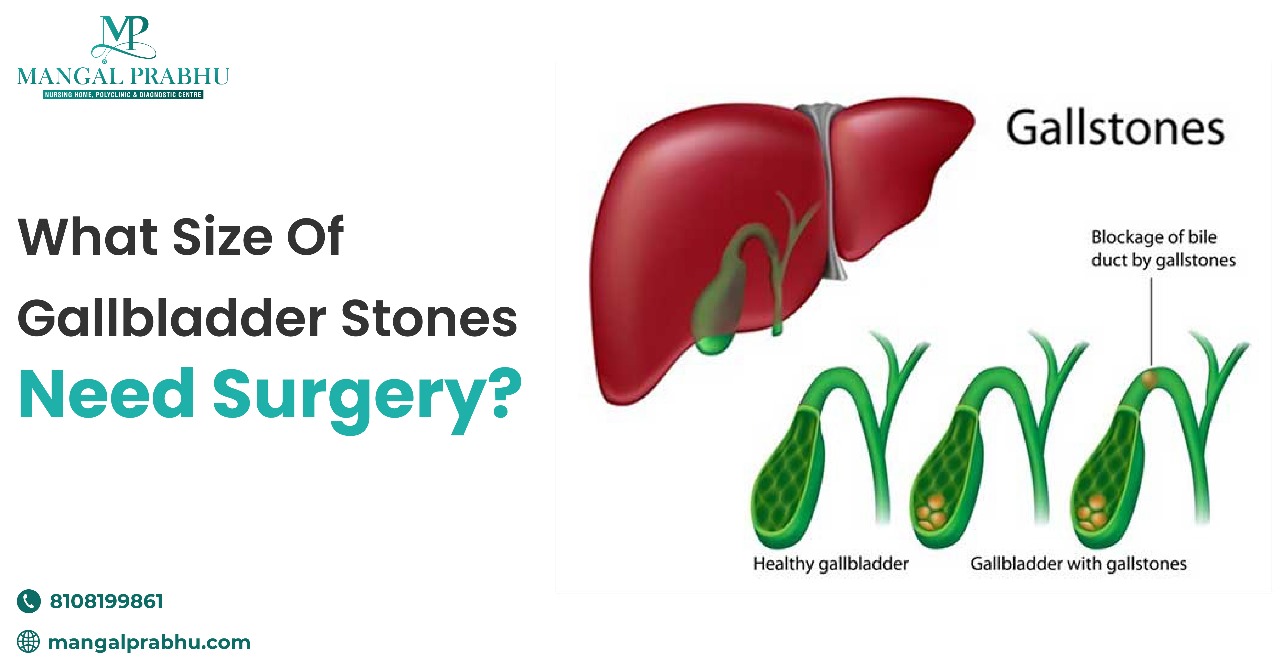
What Size Of Gallbladder Stones Need Surgery?
Gallstones Also called Cholelithiasis, gallbladder stones are the accumulation of digestive juices in a hard form in your gallbladder. These can vary in size, ranging from small grain-sized stones to tennis-ball-sized stones.
Irrespective of the size of these stones, they might require treatment as they pose a serious health threat if the stone travels to the bile duct. You can reach out to the gastroenterologist to discuss your treatment options. In the meantime, let’s learn more about gallbladder stones.
What Causes Gallbladder Stones?
A majority of gallbladder stones (around 75%) are made of cholesterol. So, those diagnosed with a higher level of cholesterol, whether because of obesity or diabetes, might develop gallbladder stones. Your liver filters cholesterol from the blood and sends it to the bile as a waste product.
Your bile duct secretes chemicals that dissolve the waste, including cholesterol. However, if the level of cholesterol in your blood increases beyond the normal level, the chemicals might be unable to dissolve them. This creates crystals, which eventually become stones. Other causes of gallbladder stones are excess bilirubin and gallbladder stasis.
What Are The Symptoms Of Gallbladder Stones?
Gallstones do not cause any problems unless they get lodged somewhere and lead to a blockage. If that happens, you might notice these symptoms:
- Extreme pain in the upper right abdomen
- The pain can radiate to different parts of your abdomen and can sometimes be felt on the shoulder blades.
- Nausea and vomiting
The pain might last for a few minutes to several hours and your upper abdomen can feel sensitive to touch.
Also Read: A Comprehensive Guide To Gallbladder Stone Removal
What Size of Gallbladder Stones Need Surgery?
As mentioned above, the symptoms you experience matter more than the size of the gallbladder stones. They can be as small as 1 centimeter but might require surgical removal of the entire gallbladder because of the painful symptoms.
Or, they could be big but cause no symptoms. Usually, gallbladder stone surgery is required when the hardened crystals have caused the blockage or the stones have led to other complications, like acute pancreatitis, or bile duct cancer.
Surgical removal of gallbladder stones is your best option to avoid any complications. For other non-invasive gallbladder stone treatments in Navi Mumbai, talk to a healthcare provider and get a diagnosis. They will check the size of these stones and the symptoms to recommend the most suitable treatment.
Laparoscopic surgery is the best for gallbladder stones. It has a faster recovery period and fewer complications than the open surgery counterpart.
What Are the Risks and Complications of Gallbladder Surgery?
You might have gas pain after a laparoscopic gallbladder stone surgery, as the gas is used to get a better view of your internal organs. There’s less risk of complications in laparoscopic surgery. In rare cases, infection, bleeding, or damage to the surrounding organs can cause complications.
Conclusion
Surgical removal of gallbladder stones is the best treatment option. The hardened crystals might not cause any symptoms initially, but there’s always a risk of infection and other complications present. So, it’s best to get them surgically removed.
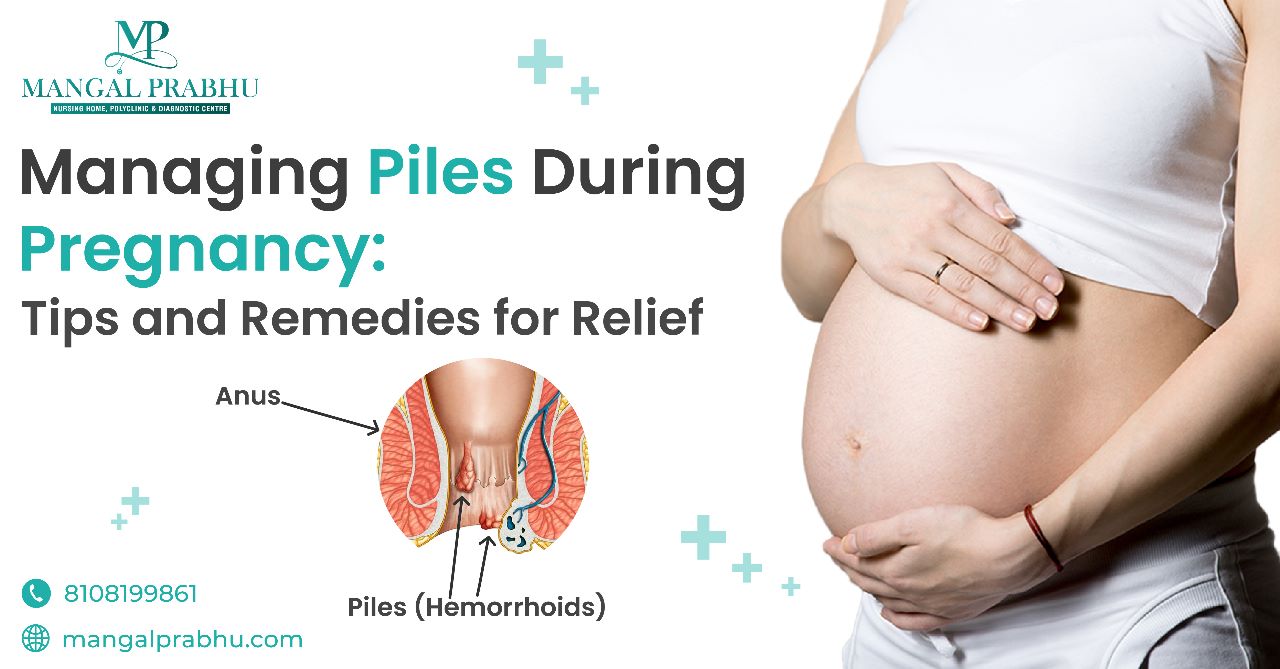
Managing Piles During Pregnancy: Tips and Remedies for Relief
Pregnancy is the most critical phase of every woman’s life, but it can also become complicated when an individual suffers from other issues. More than 2 percent of pregnant women suffer from piles of hemorrhoids for various reasons. However, treating this issue is very important as it can cause severe complications if left untreated. So if you are also looking for the best piles treatment hospital in Navi Mumbai, you must visit Mangal Prabhu Hospital to get the best treatment for piles or other issues during pregnancy.
Understanding Piles and Their Prevalence in Pregnancy
Piles or hemorrhoids are common health conditions that can cause severe complications in an adult if treated incorrectly. It is a common issue for pregnant women that causes various complications such as pain, bleeding, itching, and fullness in the rectum. Piles are usually swollen veins in the rectum and anus that happen for multiple reasons. Piles during pregnancy can be caused due to increased pressure on the pelvic area, constipation, hormonal imbalance, etc., leading to inflamed and enlarged veins in the bowel area.
Identifying the Symptoms of Piles During Pregnancy
Piles are a critical health condition that can obstruct the body’s overall functioning. This issue can worsen during pregnancy, and its symptoms can also differ from mild to severe piles. However, some of the common symptoms of piles during pregnancy are:
- Lumps around the anus
- Bleeding
- Pain
- Itching, swelling, or soreness around the anus
- The feeling of fullness in bowel movement
Also Read: What Is The Best Treatment For Piles?
Factors Contributing to Piles During Pregnancy:
Piles are an unpleasant issue caused when pressure bears down the lowest part of the digestive system or pelvic area. The pressure on the pelvic region is so heavy that the veins in the rectum and anus become inflamed and sometimes start bleeding after bowel movement. It can be caused due to various reasons, such as:
- Constipation
- Pressure of fetus
- Increase blood volume
- Lifting heavy objects
- Being obese or overweight
- Diarrhea
- Standing or sitting for an extended period
- Smoking
- Using too much steroid or other medication
- Drinking alcohol
Seeking Professional Help: When to Consult a Doctor
When you experience bleeding or other piles of piles during pregnancy, it would be best to consult the best Piles Treatment Doctor in Navi Mumbai to get an immediate and best treatment plan to overcome this issue. Experts doctors at Mangal Prabhu Hospital quickly diagnose the piles’ cause and offer a comprehensive treatment option to get through all the symptoms of piles and prevent other complications related to hemorrhoids.
Managing Piles Naturally: Home Remedies and Self-Care
Doctors offer the best treatment of piles during pregnancy, but they can also be treated with home remedies and self-care. However, some of the best home remedies to manage piles during pregnancy and relieve its symptoms are given below:
- Drinking plenty of water and other fluids
- Eat high-fiber diet
- Using sitz bath
- Exercise that improves circulation and reduces constipation
- Use over-the-counter medicines
- Applying cold compress
Conclusion
Pregnancy sometimes causes piles due to pressure on the lower part of the body or constipation. However, it can easily be managed with the help of proper home care tips to prevent future complications. However, it would be best to consult with the doctor to avoid future complications.
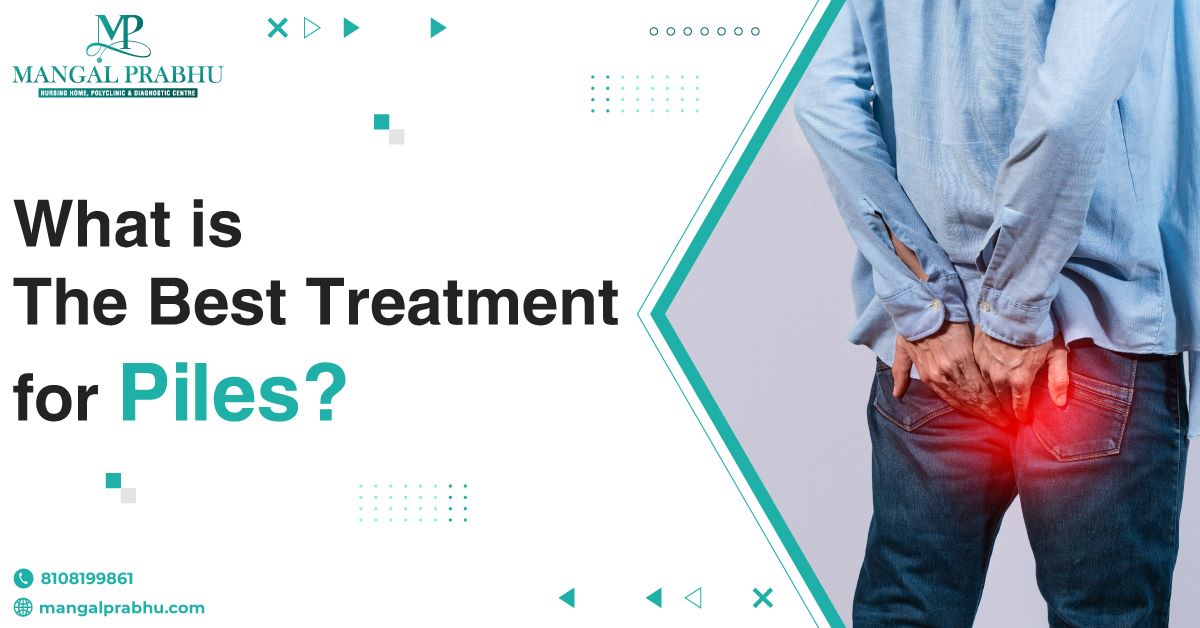
What Is the Best Treatment for Piles?
Introduction to Piles
Nearly three out of four adults suffer from piles. It can cause discomfort, pain, itching, and bleeding. Hence, it is essential to seek appropriate treatment. Generally, piles, or hemorrhoids, are swollen blood vessels in the rectal and anal areas. They can be internal, occurring inside the rectum, or external, forming under the skin around the anus. Here, you can explore the causes, symptoms, and Piles Treatment Hospital in Navi Mumbai. You can also learn about thediagnosing methods, treatment options, and prevention tips for piles.
Causes of Piles
Several factors contribute to the development of piles, including:
- Chronic constipation and straining during bowel movements are common causes.
- Prolonged sitting or standing, obesity, pregnancy, and a sedentary lifestyle can also increase the risk.
- Additionally, a family history of piles and aging are known risk factors.
Symptoms of Piles
The symptoms of piles can vary depending on their type and severity. Internal piles may cause painless bleeding during bowel movements, while external piles can lead to pain, swelling, itching, and discomfort. In some cases, blood clots may form in external piles, causing a painful condition called thrombosed hemorrhoids. However, you must see a Piles Doctor in Navi Mumbai if you find any symptoms.
Diagnosing Piles
At Mangal Prabhu Hospital, a medical professional physically examines the anal area to diagnose piles. It usually involves a visual inspection, but sometimes needs a digital rectal examination to assess the rectum. In some cases, doctors recommend additional diagnostic procedures like sigmoidoscopy or colonoscopy to rule out other potential causes.
Also Read: Understanding The Different Types Of Surgeries: A Guide For Patients
Treatment Options for Piles
The piles’ treatment aims to alleviate symptoms, reduce swelling, and promote healing. You can receive the following treatment approach for piles at Mangal Prabhu Hospital:
i) Lifestyle Modifications
Making changes to your lifestyle can help manage and prevent piles. These include maintaining a high-fiber diet, drinking plenty of water, exercising regularly, and avoiding prolonged sitting or standing.
ii) Topical Medications
Over-the-counter creams, ointments, or suppositories containing ingredients such as hydrocortisone, witch hazel, or lidocaine can temporarily relieve pain, itching, and inflammation.
iii) Oral Medications
Doctors may recommend pain relievers, such as nonsteroidal anti-inflammatory drugs (NSAIDs), to reduce pain and inflammation.
Prevention Tips for Piles:
Here are some preventive measures for the occurrence or recurrence of piles, including:
1. Maintain a High-Fiber Diet
A diet rich in fiber helps soften the stool, making it easier to pass without straining. Include fruits, vegetables, whole grains, and legumes daily.
2. Stay Hydrated
Drink adequate water throughout the day to keep stools soft and prevent constipation.
3. Regular Exercise
Engage in regular physical activity to promote healthy bowel movements and improve circulation.
4. Avoid Straining
Do not strain during bowel movements. Use a stool softener or try a different position, such as squatting, to make the process easier.
Conclusion
The treatment of piles depends on the severity of the condition and the individual’s specific circumstances. Lifestyle modifications, like dietary changes, are crucial in preventing and managing piles. You must consult a healthcare professional for an accurate diagnosis and personalized treatment plan for piles. Individuals can effectively manage piles and improve their quality of life by following the appropriate treatment options and preventive measures.
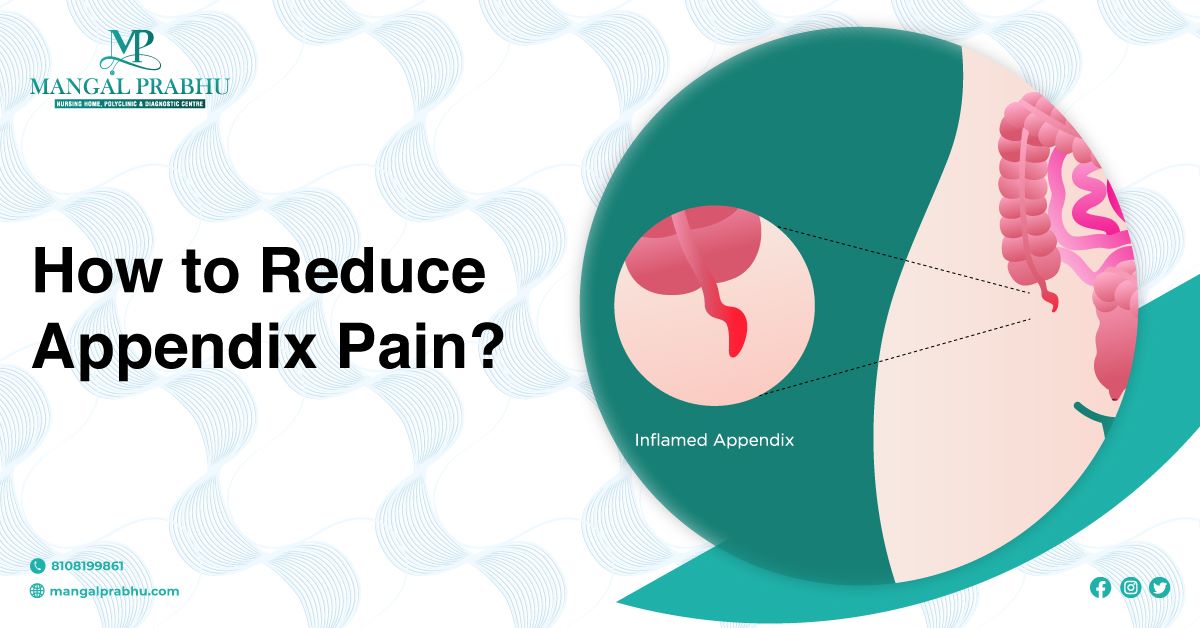
How to Reduce Appendix Pain?
The appendix is a small pouch attached to your intestine at the lower right side of your abdomen. The appendix can get blocked, causing the bacteria inside it to multiply rapidly, filling it with pus. As a result, it can get inflamed, requiring surgery.
Appendicitis can be life-threatening if the appendix bursts, spreading the bacteria to the abdominal cavity. You must get immediate appendix removal treatment in Navi Mumbai to prevent complications. Read on to learn more about appendicitis, when you need an appendectomy treatment, and how to relieve the appendix pain.
Examining the Symptoms of Appendix Pain
Appendicitis pain is extremely severe. It starts with mild cramps in your upper and lower abdomen, especially around the belly button. The pain is often described as a sharp and sudden pinch in the abdomen.
It gets worse when you move. The pain is so severe that you won’t be able to fall or stay asleep at night. The worst part is appendicitis requires almost immediate medical attention, i.e. within 24-48 hours. The pain keeps getting worse every hour. Here are some other symptoms of appendicitis.
- Loss of appetite
- Nausea and vomiting
- Fever
- Indigestion
- Diarrhea
If you feel constipated, do not use an enema, laxatives, or any medication or tool to pass the bowel movement. This can burst your appendix.
Also Read: Understanding The Different Types Of Surgeries: A Guide For Patients
Ways to Help Reduce Appendix Pain
Unfortunately, you cannot get rid of the appendicitis pain, as it tends to get worse over time. Painkillers might help for a while, but that’s only until their effect lasts. It’s best to see a general surgeon in Navi Mumbai and get an appendectomy—a surgery to remove your appendix.
Since the appendix is not an essential organ and one can easily live without it, having it surgically removed is the only treatment option for appendicitis. It’s usually performed as an emergency treatment.
Here’s what you should do to avoid complications after the surgery:
1. Limit Strenuous Activities:
Do not practice any strenuous activity that puts unnecessary pressure on your abdomen or the site of the operation. If the surgery was performed laparoscopically, you can start moving 3-4 days after the operation, however, open surgery involves a longer recovery period.
2. Use Support When Moving:
Place a soft pillow on your abdomen and hold it gently when you cough, laugh, or move.
3. Contact Your Doctor:
If you still feel sharp or mild pain, contact your doctor immediately to seek medical help.
4. Rest:
Take leave from work or your classes for one week. You need rest post-surgery to speed up the healing. Take short walks initially. You can return to work when you feel alright. It’s best to talk to your doctor about when you can resume your work. Avoid strenuous activities for at least a month, so that your body can heal faster.
Conclusion
Appendicitis is an emergency medical condition that requires immediate treatment. If you notice the above-mentioned symptoms, contact a doctor immediately. Usually, people don’t have much time to prepare for appendectomy, as the surgery is an emergency treatment that’s performed during diagnosis.
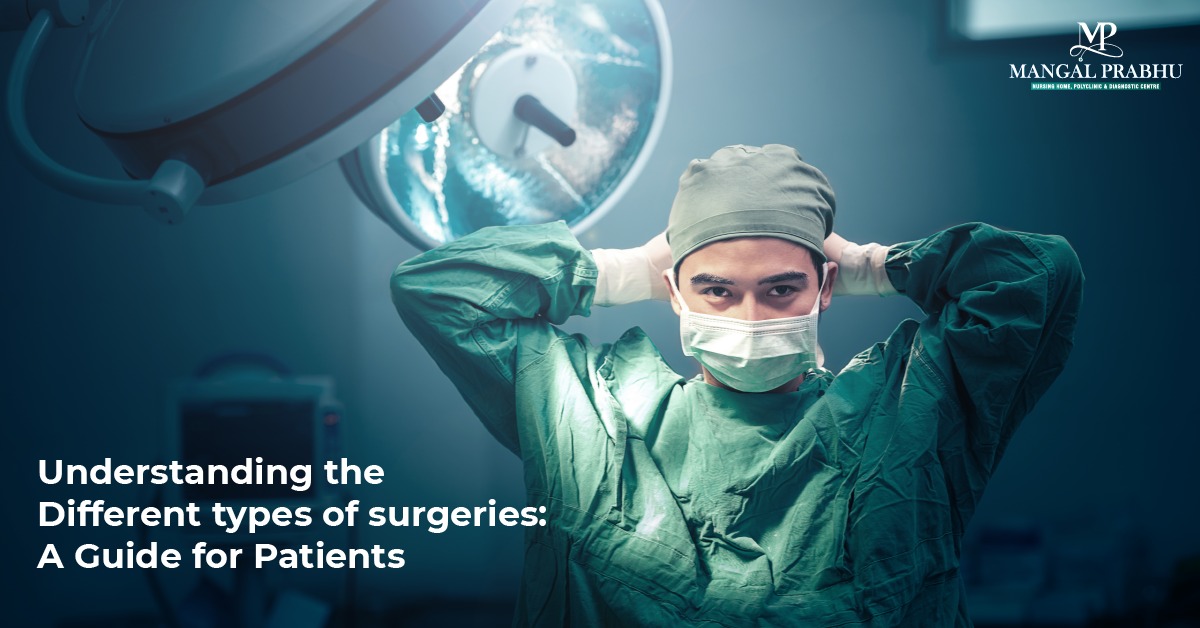
Understanding the Different Types of Surgeries: A Guide for Patients
With every different condition, there are also additional surgeries to eliminate the problem and improve the patient’s body’s functioning. It is classified in several ways, including location in the body, magnitude, and type of conditions such as oncologic, neurologic, orthopedic, etc. However, this guide will help you understand some of the most common surgical operations and know which surgery you need.
The Importance of Different Types of Surgeries
Every surgery has a different significance for a patient and is done for various reasons, which can be the following:
- Repair or remove damaged organs or tissues
- Transplant organ or tissue
- Redirecting blood vessels
- Improve physical appearance
- Eliminate an obstruction
- Implant electronic or mechanical devices
Types of Surgeries
Various types of surgeries vary according to the patient’s condition and complexity. However, here are some of the most common surgeries.
1. General Surgery
It is a surgical operation that concentrates on abdominal contents and the alimentary canal, such as the stomach, esophagus, large intestine, small intestine, appendix, pancreas, thyroid, gland, etc. General surgery also deals with soft tissue trauma, skin, breast, etc. Some examples of general surgery are hernia surgery, endocrine surgery, and appendectomy.
2. Orthopedic Surgery
It is a branch of surgery that deals with musculoskeletal conditions. It effectively treats sports injuries, infections, spine disorders, conventional disorders, etc. bone tumor surgery, joint reconstruction, rheumatoid surgery, and sports surgery are some examples of orthopedic surgery.
3. Cardiothoracic Surgery
It is a surgical procedure that treats internal organs in the thoracic cavity. Cardiothoracic surgery usually treats issues with the lungs, heart, and other mediastinal or pleural structures. Cardiothoracic surgery, cardiac surgery, cardiovascular surgery, and congenital heart surgery are some examples of cardiothoracic surgery.
4. Neurosurgery
It is a field of medicine that deals with the surgical operation of the nervous system. It primarily treats issues related to the spinal cord, brain, and nerves. Traumatology, neuro-oncology, pediatric neurosurgery, spinal surgery, and skull-base surgery are some of the most common examples of neurosurgery.
Procedures for Each Type of Surgery
As every issue requires a different type of surgery, the procedure for each surgical operation also differs.
General Surgery Procedures:
The general surgery procedure includes preparation, tests, recovery, after-surgery pain management, and discharge planning. However, you can get the following common practice of a general surgeon in Navi Mumbai in Mangal Prabhu Hospital.
- Appendectomy
- Gallbladder Removal
- Hernia Repair
Orthopedic Surgery Procedures:
The orthopedic surgeon works on the following diagnosis and procedures for orthopedic surgery.
- Joint Replacement
- Spine Surgery
- Arthroscopy
Cardiothoracic Surgery Procedures:
Cardiac surgeons and cardiologists work well together to treat different cardiological issues. However, a cardiac surgeon may offer some common surgical services and procedures.
- Heart Bypass Surgery
- Heart Valve Replacement
- Lung Surgery
Neurosurgery Procedures:
Neurologists use advanced tools and technologies and offer the following procedures and services to treat neurological conditions.
- Brain Tumor Removal
- Spinal Cord Surgery
- Deep Brain Stimulation
Conclusion
If you are also looking for the best place to do your surgery without any severe complications, you must consider Mangal Prabhu Hospital. It is a prominent multispeciality hospital In Navi Mumbai that offers various treatment plans, surgeries, and the best medication.

A Comprehensive Guide to Gallbladder Stone Removal
The organ known as the gallbladder, which is located underneath the liver, generates suspended solids called gallstones. They are made up of calcium salts, bile pigments, and cholesterol. Gallstones can be single or multiple and vary in size from tiny stones to big golf balls.
Whenever gallstones obstruct the bile ducts, which are tubes that convey bile from the liver to the small intestine, difficulties might result. Pain, inflammation, infection, and other problems may come from this. Gallstones can cause symptoms varying from none at all for some people to severe upper right abdominal discomfort, nausea, vomiting, and fever for others.
According to a Surgery Hospital in Navi Mumbai, a medical operation called gallbladder stone removal removes gallstones from the gallbladder. Abdominal discomfort, nausea, vomiting, and bloating are just a few of the symptoms that gallstones can produce. They can also result in consequences like inflammation, infection, and jaundice. The removal of gallbladder stones can be accomplished through surgery, non-surgical approaches, and a variety of medications.
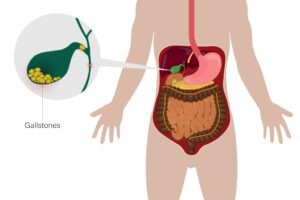
Medication:
Medication might be the best course of action for those with little gallstones that are not generating noticeable symptoms. Gallstones can be eliminated throughout the period with the use of drugs like Ursodiol and Chenodiol. These drugs function by lessening the amount of cholesterol the liver produces, which can aid in preventing the development of new gallstones and dissolving old ones.
Also Read: Do I Need Surgery For Hernia?
Nonsurgical Techniques (Gallbladder Stone Removal Without Surgery):
The removal of gallstones can be accomplished by a number of non-surgical techniques. These treatments are frequently done as outpatients and don’t call for a night in the hospital. They consist of:
- An endoscope, a flexible tube with a camera, and a light at the end are used during endoscopic retrograde cholangiopancreatography (ERCP) to view the bile ducts. The gallstones are extracted using a tiny basket once the bile ducts have been discovered and a little incision has been created in the duct.
- Extracorporeal shock wave lithotripsy (ESWL): During this operation, gallstones are broken up into smaller pieces using shock waves so that they can be expelled from the body through the bile ducts.
- Percutaneous transhepatic cholangiography (PTC): During this operation, a needle goes under the skin into the liver and into the bile ducts to inject a dye. The gallstones then are located using X-rays, and a tiny incision is performed.
Surgery (Gallbladder Stone Removal Surgery):
Surgery may be required to extract the gallbladder in patients with bigger or more numerous gallstones. As per a General Surgeon in Navi Mumbai, laparoscopic surgery is the most common surgery for removing the gallbladder. It involves several small abdominal incisions and the use of a laparoscope, a thin, illuminated tool, to remove the gallbladder.
Compared to conventional surgery, this method requires less recuperation time and is less intrusive. The gallbladder may sometimes require to be extracted by surgical intervention. This surgery entails making a bigger abdominal incision and removing the gallbladder by hand. Patients who are poor candidates for laparoscopic surgery often undergo open surgery.
Recovery (Gallbladder Stone Removal Recovery Time):
According to the procedure used, the recovery period after gallbladder stone removal varies. Recovery from medication and non-surgical methods is frequently quicker than from surgery. Surgery patients might feel some discomfort and pain for a few days following the procedure, and they might need to limit their physical activity for a few weeks.
Patients will need to adjust their lifestyles following gallbladder ectopy in order to make up for the absence of the organ. Patients may feel alterations in digestion because the gallbladder controls the storage and release of bile, especially after consuming fatty or oily foods. To encourage healthy digestion and avoid difficulties, it is crucial for individuals to maintain a healthy diet and engage in regular exercise.
Conclusion:
In conclusion, the removal of gallstones from the gallbladder is a routine medical treatment. Medication, non-surgical treatments, and surgery are just a few of the ways that gallbladder stones can be removed. The size, location, and general health of the patient all factor into the recommended course of treatment. Healing times vary according to the procedure type, and patients may need to adjust their lifestyles to account for the removal of their gallbladder.
